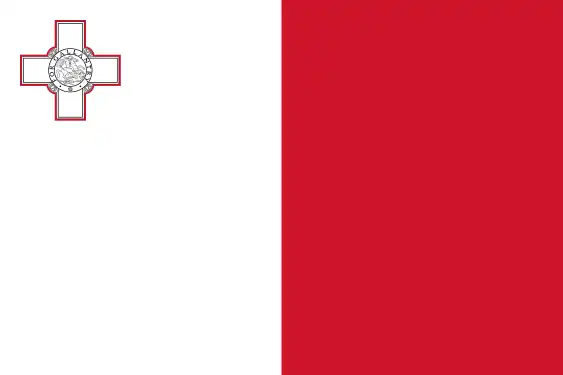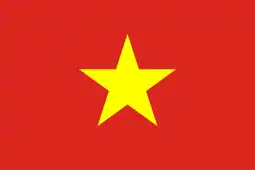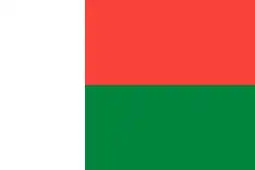The Laughing Cow
The Laughing Cow (French: La vache qui rit) is a brand of processed cheese products made by Fromageries Bel since 1921. The name refers in particular to the brand's most popular product, the spreadable wedge.[4]
| The Laughing Cow (La Vache qui Rit) | |
|---|---|
 | |
| Other names | Laughing Cow Cheese |
| Country of origin | |
| Region | Lons-le-Saunier[2][3] |
| Source of milk | Cow |
| Pasteurised | Yes |
| Texture | Semi-soft |
| Aging time | Made from aged cheeses, but not aged itself |
| Certification | Trademarked brand name |
Description
The cheese is a blend of cream, milk, and fresh and aged cheeses, particularly comté, which are pasteurized to stop the ripening process. Versatile and portable because of its pasteurization process, Laughing Cow can remain unrefrigerated for a limited length of time. The archetypal Laughing Cow cheese comes wrapped in the individual serving-sized foiled wedges and they are packaged in a round, flat box. Consumers have to pull a little red thread around the box to open it and the foil packaging also features a red tab for opening. The company was founded in 1921. The Laughing Cow is available in these formats in different worldwide markets:
- Triangles, squares, or rectangles in various flavors.[5]
- Spreadable tubs and jars
- The Laughing Cow Dip & Crunch (or Pik & Croq in mainland Europe), previously named Cheez Dippers, which are snacks consisting of bread sticks and cheese spread, and these come in four varieties; original, light, hazelnut and pizza
- Slicing blocks of The Laughing Cow with a harder consistency like that of butter
- Ma P'tite Vache Qui Rit, pods of cheese spread to be eaten out of the pod with a spoon, especially for younger children
- Toastinette processed cheese slices, similar to Kraft Singles
- Bite-sized cubes, in various flavours and designed to be served as aperitifs at cocktail parties - which are called Cheez & Fun in many European countries, and also Snack Bites in the UK, Apéricube in France, Belgium and the Netherlands, PartyCubes in Canada, Mini Cubes in Australia and New Zealand, and Belcube in Japan and South Korea. They are produced in 24- or 48-cube boxes of one flavour, e.g. blue, ham, salmon, chili pepper and olive, or they are produced in 24- or 48-cube boxes of a particular theme, e.g., 'Cocktails du Monde', 'Petites Recettes', 'Tex-Mex' and 'Indian'.
Discontinued formats of The Laughing Cow include:
- Giggles/Blop processed cheese pods for younger children
- Squeeze bottles
- Big Cheez Dipper (a larger version of Cheez Dippers)
- Cheez Double Dippers (which contained crispy bacon flavour bits in addition to bread sticks and cheese spread).
The Laughing Cow USA introduced a TV commercial in 2009 where the company introduced a new slogan, "Have you laughed today?". In 2010 they updated the brand's website to include cheese recipes.

Laughing Cow cheese is available in its original flavour, a light version with 7% fat, and an ultra-light version with 3% fat. In addition, flavoured versions of the cheese (such as ham, gruyère, garlic, paprika, mushroom, chèvre, bleu, hazelnut, pizza, jalapeño and onion) are also available in various markets worldwide.
Evolution of the brand
The Laughing Cow is a red and white cow depicted as being jovial, and almost always wearing ear tags that look like the round boxes the cheese comes in. On April 16, 1921, Léon Bel trademarked his brand, as La Vache Qui Rit, in France.[6][7] Bel had made the original drawing himself, after seeing a travelling meat wagon during World War I called "La Wachkyrie", a play on the word for Valkyrie.[7] The cow in the original drawing was not red and did not wear ear tags. In 1924, illustrator Benjamin Rabier edited the drawing into something more like the image that prevails today.[6] The blue and white stripes around the box date from 1955. Since 1976 both ear-tag boxes have been shown with the top side visible. Before then, one tag showed the top and the other showed the bottom side. The current logo uses the Droste effect, with the laughing cow appearing inside the ear tags.[8]
Kiri (pronounced in the same way as "qui rit") is a separate brand that Bel established in 1966.[9]
Worldwide popularity
The cheese has long been popular in the United Kingdom and Canada as a children's snack.[10] The cheese has also been a constant, but hardly popular, product in the United States for a number of years.
Localized names include:
- La Vache qui Rit in
 France,
France, .svg.png.webp) Canada (French-speaking areas only),
Canada (French-speaking areas only), .svg.png.webp) Switzerland,
Switzerland, .svg.png.webp) Belgium, the
Belgium, the  Netherlands,
Netherlands,  Norway,
Norway,  Greece,
Greece,  Lithuania,
Lithuania,  Malta,
Malta,  Algeria,
Algeria,  Morocco, and other Arabic-speaking countries
Morocco, and other Arabic-speaking countries - The Laughing Cow in English-speaking countries, the rest of Canada, and
 Indonesia
Indonesia - Die Lachende Kuh in German-speaking countries except for Switzerland
- La Vaca que Ríe in Spanish-speaking countries
- A Vaca que Ri in Portuguese-speaking countries
- Весёлая Бурёнка (Vesyolaya Buryonka) in
 Russia
Russia - ラッフィングカウ (Raffingu Kau) in
 Japan[11]
Japan[11] - 래핑카우 in
 South Korea
South Korea - 乐芝牛 in
 China
China - 笑牛牌 in
 Hong Kong
Hong Kong - La Mucca che Ride in
 Italy
Italy - Den Skrattande Kon in
 Sweden
Sweden - Den Leende ko in
 Denmark
Denmark - La Vache qui Rit, Gülen İnek in
 Turkey
Turkey - Krówka Śmieszka in
 Poland
Poland - Nevető tehén in
 Hungary
Hungary
- Весела Корівка (Vesela Korivka) in
 Ukraine
Ukraine
- Veselá kráva in the
 Czech Republic
Czech Republic - Η Αγελάδα που Γελά (I Agelada pou Gela) in
 Cyprus
Cyprus - گاو خندان (Gav e Khandaan) in
 Iran
Iran - Sapi Ceria in
 Indonesia (formerly)
Indonesia (formerly) - Con Bò Cười in
 Vietnam
Vietnam - Ilay Omby Vavy Mifaly in
 Madagascar
Madagascar - לה וואש קירי in
 Israel
Israel
Other associations
- The product name and indicia were adopted by the crew of World War II German submarine U-69, whose sinking of the SS Robin Moor was significant to US entry into World War II.
- La Vache qui Rit is the name of an EP by late 1980s Washington, D.C., punk band Rain with connection to Dischord Records.
- Le Vache qui Rit is the name of a 1982 EP by UK Anarchist Punk band Zounds.
- La Vache Qui Rit is the name of a finishing move in the 1994 video game Primal Rage. The character Vertigo will move up to an opponent and transform them into a cow, which makes a disconcerted moo as it runs away.
- La vache qui lit ('The reading cow') is the children's book prize of the city of Zürich, and a children's book program in the Auvergne region of France.[12]
- The Laughing Cow's mascot appears on the cover of the 2002 album Human by UK electronic musician Freeform.
See also
- Emmi AG - manufacturer of Swiss Knight brand of spreadable cheese wedges
- Dairylea (cheese) - Similar popular spreadable cheese in UK/Ireland
- Babybel - another internationally distributed snack-sized cheese product produced by Fromageries Bel
References
- "The Laughing Cow, more than 90 years and still smiling". Groupe Bel. Archived from the original on 11 July 2016. Retrieved 28 May 2017.
- Birck, Danielle (6 November 2009). "La Vache qui rit". Radio France Internationale (in French). Retrieved 28 May 2017.
- "Découvrir". The House of the Laughing Cow (in French). Retrieved 28 May 2017.
- "Welcome to the world of The Laughing Cow!". The Laughing Cow. Retrieved 2022-11-21.
- "The Laughing Cow Spreadable Cheese Wedge Variety pack". Amazon. Retrieved 2021-10-22.
- "Bienvenue à la Vache Qui Rit (1921)". National Institute of Industrial Property (France) (INPI) (in French). 12 January 2016. open the "+" beside "Combien de portions de...". Retrieved 2023-03-20.
- Déniel, Patrick (2011-04-13). "Les secrets de La Vache Qui Rit enfin percés !". L'Usine nouvelle. Archived from the original on 2021-12-21. Retrieved 2023-03-20.
- Merow, Katharine (2013). "Escher and the Droste Effect". Mathematical Association of America. Archived from the original on 2 August 2013.
- "Kiri". Le Groupe Bel. Retrieved 2021-07-24.
- "Is Laughing Cow Cheese Gluten-Free?". Vegiac. 29 October 2021. Retrieved 2022-11-25.
- "CSR" CSR情報 (in Japanese). ベル ジャポン (Bell Japon). お客様のニーズにお応えする商品. Archived from the original on 2017-05-09. Retrieved 2021-09-22.
- "Les Editions la vache qui lit". editionslavachequilit.com (in French). Retrieved 28 May 2017.
External links
- The Laughing Cow at The Bel Group's web site
- The Laughing Cow Brand site features cheese recipes and snack cheese information
- La Vache qui rit Archived 2018-06-01 at the Wayback Machine official site (in French)
- La Maison de La Vache qui rit – A museum operated by Fromageries Bel. (fr:La Maison de La Vache qui rit)